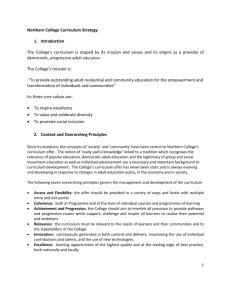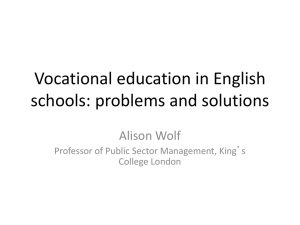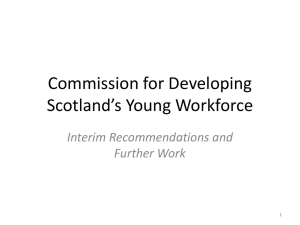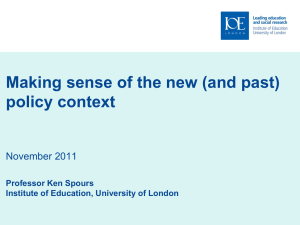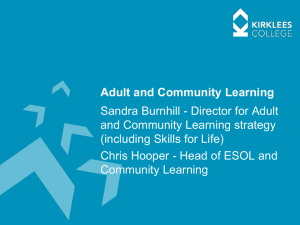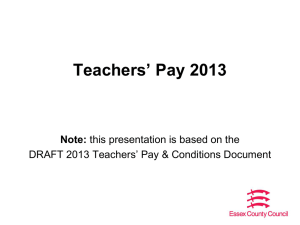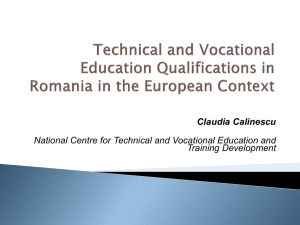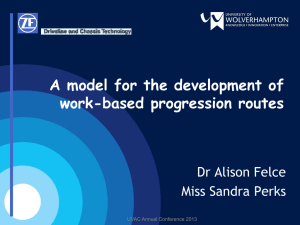View presentation here
advertisement
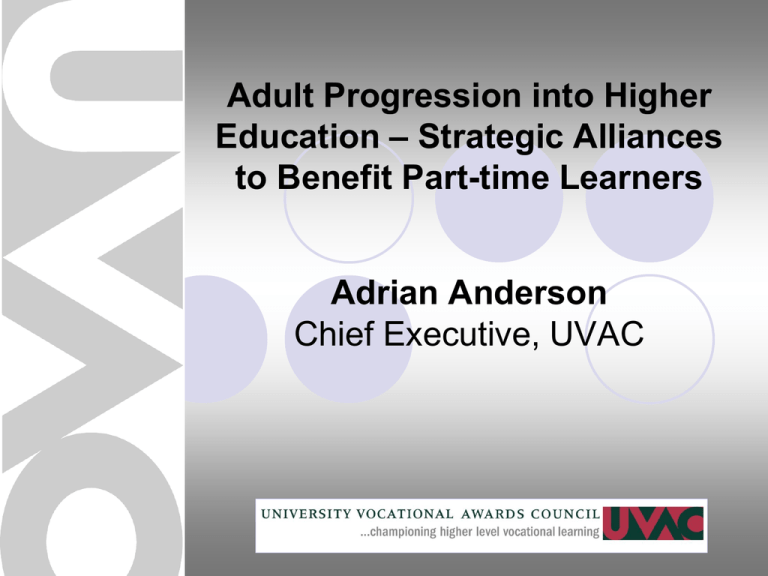
Adult Progression into Higher Education – Strategic Alliances to Benefit Part-time Learners Adrian Anderson Chief Executive, UVAC Presentation Coverage Vocational progression to ‘Higher Education’ and what we define as ‘Higher Education’ Role of Higher Education in skills development, work-based learning and raising the skills levels of the workforce Strategic Alliances - Individuals, Employers, HE, FE, LLNs, professional bodies, SSCs, awarding organisations, private providers Actual Vocational Progression to HE Percentage of A Level and Vocational Learners in England progressing to HE 90% 80% 70% A Levels 90% 60% 50% BTECs 40% 30% 41% Advanced Apprenticeships 20% 10% 0% 4% Progression Routes What we mean by Higher Education In the development of vocational progression, Government policy focus should be on progression to any higher level learning programme (e.g. Foundation degrees, honours degrees, HNDs/HNCs, technical qualifications at level 4, higher level NVQs, other higher level qualifications awarded by awarding bodies regulated by Ofqual and recognised professional qualifications) including ‘bite-sized’, accumulative progression through accredited units, based on the best interests of the vocational learner and where existing, their employer. Recommendation in ‘Progression from vocational and applied learning to HE in England’ Professor Joy Carter, chair of UVAC The Rationale for Progression - Skills needs – By 2017 47% of all UK employment will be in managerial, senior official, professional and technical occupations. - Employability – Wage returns offer a significant incentive for progressing to level 4 – particularly for women. - Social mobility – More than twice as many young people from lower socio-economic groups choose vocational routes as do young people with parents in professional occupations. HE Programme Design and Delivery - Learners who have followed level 3 Vocational programmes are often used to learning in different ways to those who have followed A levels. - Apprentices are employees – HEIs/FECs/providers will need to meet employer as well as individual needs. - Employers will want different forms of provision, short accredited HE courses, work-based, delivered flexibly, with flexible start and completion dates and assessment systems based on the demonstration of competence. The Role of HE in Workforce Development? The HE share of the UK market for higher level CPD is estimated at 6% Employees see professional bodies and employers as far more credible deliverers of work-based learning and development than HE (Roodhouse and Mumford) Skills Strategy ‘Skills for Sustainable Growth’ light on HE The Qualifications and Credit Framework (QCF), Higher Apprenticeship, professional qualifications offer an alternative to accrediting and supporting higher level skills Government, Skills and HE Apprenticeships etc seen as an alternative to three year degrees In Skills for Sustainable Growth HE is predominately seen as a destination for Apprentices The place of Foundation degrees vis-à-vis Apprenticeships Meeting the higher vocational learning needs of employers – in the workplace A business service rather than provider of ‘courses’ Consultancy/TNA Bespoke service Flexibility Use of AP(E)L Use of NOS Support for and accreditation of work-based learning Accreditation linked to a licence to practice Responsiveness Bite sized provision and smaller programmes Meeting the higher vocational learning needs of employees Accredited qualifications - A tool for career progression and social mobility - HE qualifications can accredit skills and knowledge providing a currency and adding value to a CV Why HE should get more involved in this market A source of potential learners and income HE has something to offer - Accreditation, a BRAND and respected qualifications can measure skills and competence - A link to research expertise and full-time programmes - Supports the development of accredited work-based learning placements for ‘full-time’ students - Helps prevent the development of glass ceilings, supports social mobility, provides common currency for vocational and academic learning Strategic Alliances – Greater Value than Individual Approaches? Expertise some generalisations: FECs – local focus, cost effective, know the learners, delivery expertise, bridge the FE/HE gap, experience of QCF Commercial Providers – know how to sell and charge, targeted provision, know the customer, delivery expertise Professional Bodies – Licence to Practice LLN – networks, partnerships, IAG, marketing and progression expertise Employers – their contribution?

